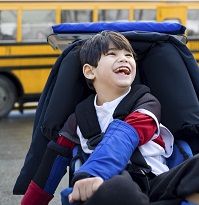State-of-the-Art Rehabilitation Strategies in Children with Cerebral Palsy
Research and real-world experience has shown interventions such as constraint therapy, botulinum toxin therapy, and interactive computer play to be effective in children and adolescents with cerebral palsy.

During the Presidential Symposium at the 43rd Annual Child Neurology Society Meeting, held in Columbus, OH, October 22-25, Darcy Fehlings, MD, MSc, FRCP(C) reviewed the current state of the art in rehabilitation strategies for children with cerebral palsy, focusing on three “motor” interventions: constraint therapy, botulinum toxin therapy, and interactive computer play.
Fehlings is head of the Division of Developmental Paediatrics and Professor of Paediatrics at the University of Toronto. She is also the Bloorview Children’s Hospital Foundation Chair in Developmental Paediatrics.
There are three primary types of cerebral palsy (spastic, dyskinetic, and ataxic), each characterized by neuromuscular mobility impairment, though with different clinical features. There is also a mixed form of cerebral palsy that is associated with symptoms from each subtype. Fehlings said there are several tools and instruments available that can help assess the severity of hypotonia in cerebral palsy, but a standardized clinical tool to differentiate between forms of hypertonia does not exist. She said the current standard for assessment is the neurological exam, which also lacks standardization and is dependent on the experience and skill of the examining physician.
Constraint Induced Movement Therapy Intervention (CIMT) involves constraining the unaffected limb with a cast or removable restraint and providing repetitive, intensive practice to the affected limb, with the goal of improving amount of spontaneous “hemiplegic” limb use and motor control. Fehlings said constraint works in patients with cerebral palsy by enhancing activity in the contralateral primary somatosensory cortex and the primary motor cortex, and by promoting a “rebalancing of hemispheric activation and resting state from Ipsi greater than contra to Ipsi equals contra.”
Potential challenges and barriers to providing constraint interventions include scheduling and lack of time to devote to intensive training, patient suitability, and the need to create developmentally appropriate programs for preschool and school-age children.
Fehlings said CIMT has a “significant body of evidence supporting its use,” and that the central mechanism of action of CIMT includes “rebalancing of hemispheric activation, shifting neural activity to injured hemisphere, and enhanced sensory awareness of hemiplegic limb.” When implementing CIMT programs, she reminded the audience to keep assessment simple, consider “constraint camps” in the summer for school-age kids, and a caregiver-mediated model for pre-school-age kids.
Turning to the topic of botulinum toxin type A therapy in children and adolescents with cerebral palsy, Fehlings said this form of treatment enhances motor function in the presence of hypertonia, enhances ease of care giving in the presence of hypertonia, relieves pain from hypertonia (dystonia, muscle spasms), and paired with serial casting can promote maintenance of range of motion.
Virtual reality therapy (VRT) and interactive computer play (ICP) are also emerging areas of therapy for this patient population. Although there is some overlap between the two terms, Fehlings defined VRT as “a computer based technology that allows users to interact with a multi-sensory simulated environment that is similar to a real-life experience and receive real-time feedback on their performance.” She defined ICP as a “any computer game or virtual reality technology where the individual can interact and play with virtual objects in a computer-generated environment.”
Immersive ICP holds the potential of channeling children’s and teen’s interest in playing games to provide health benefits. In children with cerebral palsy, effective ICP can provide cognitive training, enhance physical activity and fitness, facilitate motor learning, and improve social responsiveness.